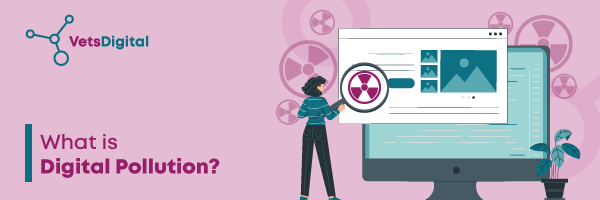What is Digital Pollution?
July 1, 2024
As veterinary professionals, we’re all increasingly aware of the physical pollution that is affecting our beautiful planet and the species that inhabit, but did you know that our digital world and the actions we take online also creates pollution which contributes to the damage of the world?

What exactly is digital pollution?
The ‘cloud’ has made it possible for us all to store thousands of photographs, videos and other media, but have you ever thought about where all this data actually lives? Rather than floating somewhere in the ether, the data is physically stored within huge data centres, which are consuming large quantities of electricity.
The term digital pollution refers to the overall environmental impact that our digital world is having on our physical surroundings, including energy consumed by digital platforms, data storage, and electronic waste.
What is the impact of digital pollution?
Research shows that streaming an hour of on-demand video content creates 55g of carbon emissions [1]. Although this is minimal when compared to other activities that many of us do every day, it has a cumulative impact. In 2021, Netflix viewers spent more than six billion hours watching the 10 most popular shows on the platform, which created carbon emissions equivalent to travelling more than 1.1 billion miles in a car [2].
By 2030, data centres are predicted to be responsible for consuming up to 4% of the world’s total electricity output, with the average hyperscale data centre consuming the same amount of electricity as 37,000 homes [3].
It is also important to consider the materials that are required to make the technology we now rely on. Not only do rare metals need to be mined, which puts pressure on the environment and the communities of people who conduct this dangerous work, but the rate at which we are discarding old technology is causing pollution in landfill sites and contributing to increasing levels of toxic waste.
Tips to reduce your veterinary practice’s digital footprint
All businesses have a responsibility to minimise digital pollution, so the good news is that there are a variety of tangible steps that you can take to reduce your digital footprint in practice.
1. Adopt green IT practices
From optimising your computer systems to make them more energy efficient to utilising AI technology that can help you to better manage your energy usage, there are many ways that you can start to reduce the amount of digital pollution your practice is creating.
It is worth emphasising here that the recent upsurge in AI technology usage has increased energy usage, so it is important to only use AI in ways that make your practice more efficient if minimising the amount of digital pollution you are generating is important to you.
2. Utilise sustainable cloud storage and server management
Switching to cloud storage services powered by renewable sources of energy and utilising hosting services with carbon neutral credentials is a straightforward way to reduce your digital footprint.
3. Recycle with care
If you have a piece of practice technology that is now obsolete, it is important to take steps to recycle or dispose of it in such a way that it won’t have a negative impact on our environment. There are many options available to you here, including donating computers you no longer need to a local charity or school and working with organisations that specialise in reusing or refurbishing components to prevent them from entering landfill unnecessarily.
4. Incorporate sustainability into your brand values
When everything you do is informed by a desire to be a sustainable and environmentally conscious practice, you will find it easier to keep your carbon footprint to a minimum. Putting together an internal awareness campaign for your team can be an excellent way to ensure everyone is on the same page. Even small steps can make a big difference cumulatively, such as powering down computers when they’re not being used or ensuring that printers are enabled to print double sided to reduce your paper consumption.
5. Minimise digital clutter
If there is no need to keep a document, file or database, it is good practice to remove it from your system so that energy is not being wasted on information that is no longer relevant. This can also have a positive impact on your day-to-day operations, as there will be no need for your team to look through countless files in search of the specific piece of information needed.
6. Offset your carbon emissions
Businesses across a range of sectors have started to offset their carbon emissions by forming partnerships with organisations that plant trees or remove plastic from our oceans every time a customer makes a purchase. This could be something to consider for your practice, which will have the added advantage of appealing directly to environmentally conscious pet owners.
Digital pollution is becoming an increasingly concerning issue that we should all be thinking about. By getting ahead of the game and ensuring that your systems are as streamlined and energy efficient as possible, you can start to minimise your digital footprint and reduce your practice’s energy consumption.
For more information on how to create a ‘greener’ veterinary practice, you can take a look at the useful resources from IiE, join Vet Sustain or even have a read of our blog from last year:
The Benefits of Investing In The Environment And How Your Veterinary Practice Can Get Started
[1] https://www.carbontrust.com/our-work-and-impact/guides-reports-and-tools/carbon-impact-of-video-streaming
[2] https://www.theguardian.com/tv-and-radio/2021/oct/29/streamings-dirty-secret-how-viewing-netflix-top-10-creates-vast-quantity-of-co2
[3] https://datacentremagazine.com/articles/efficiency-to-loom-large-for-data-centre-industry-in-2023
Categorised in: News


